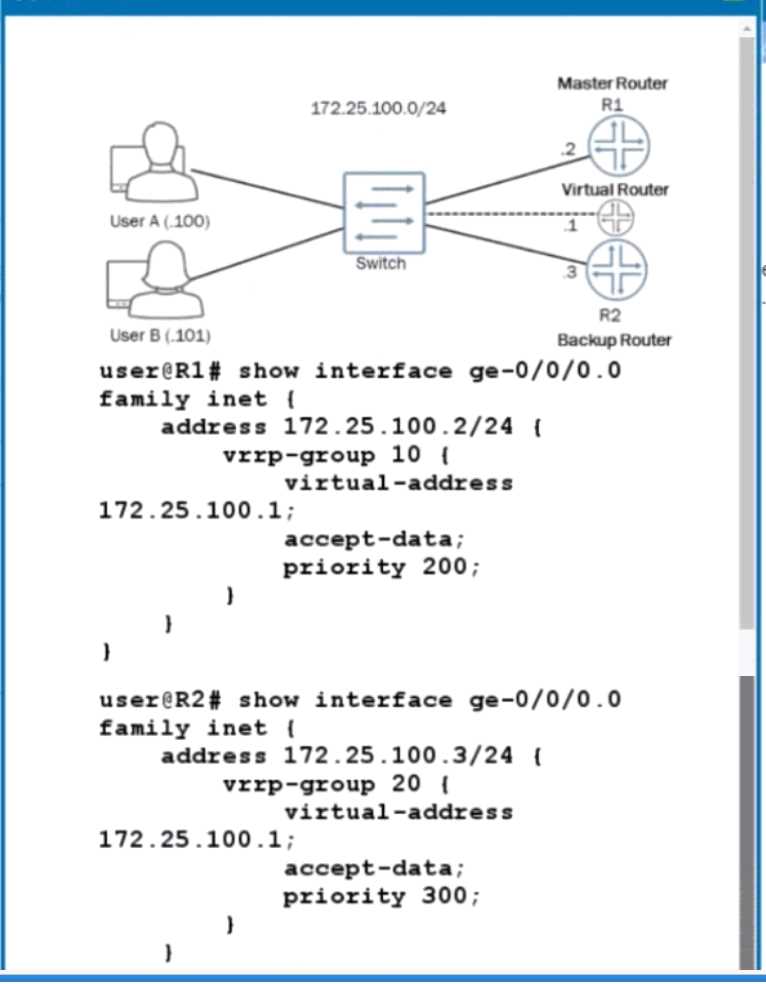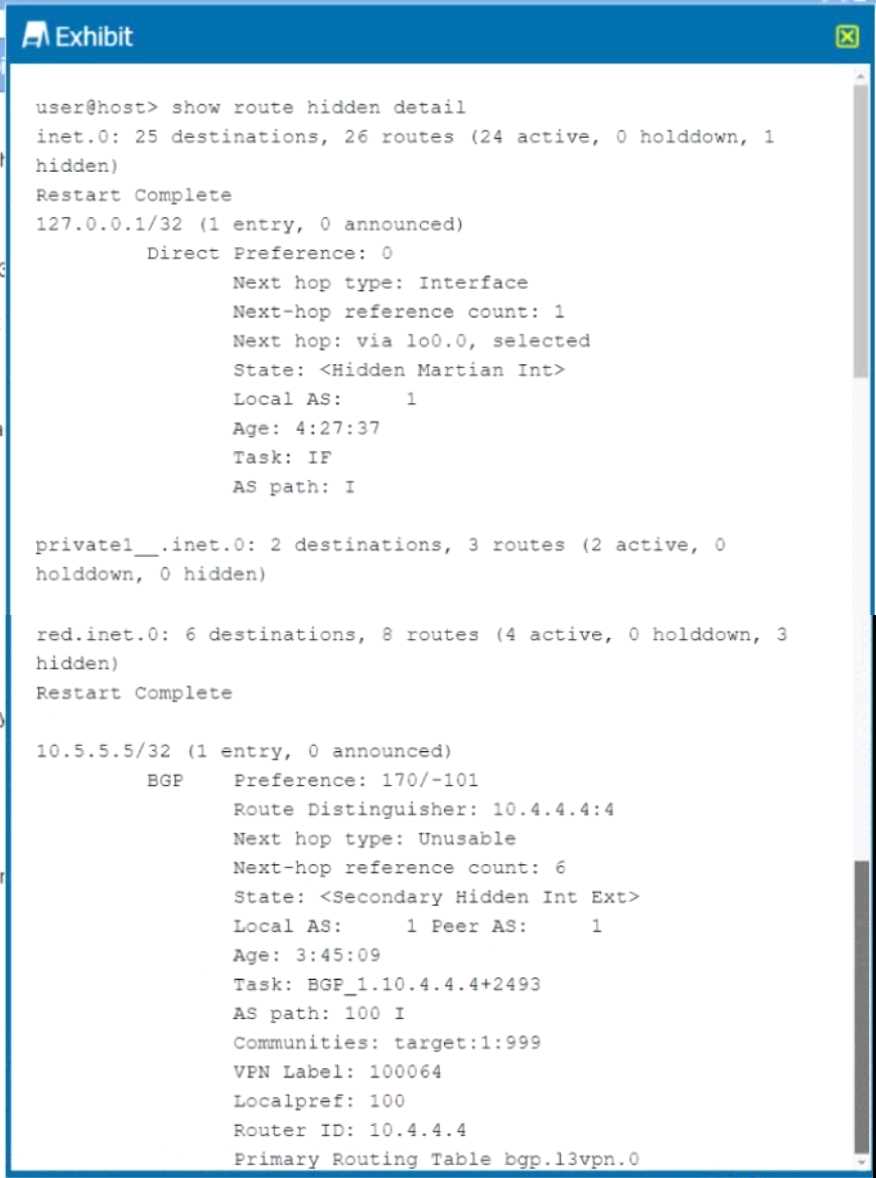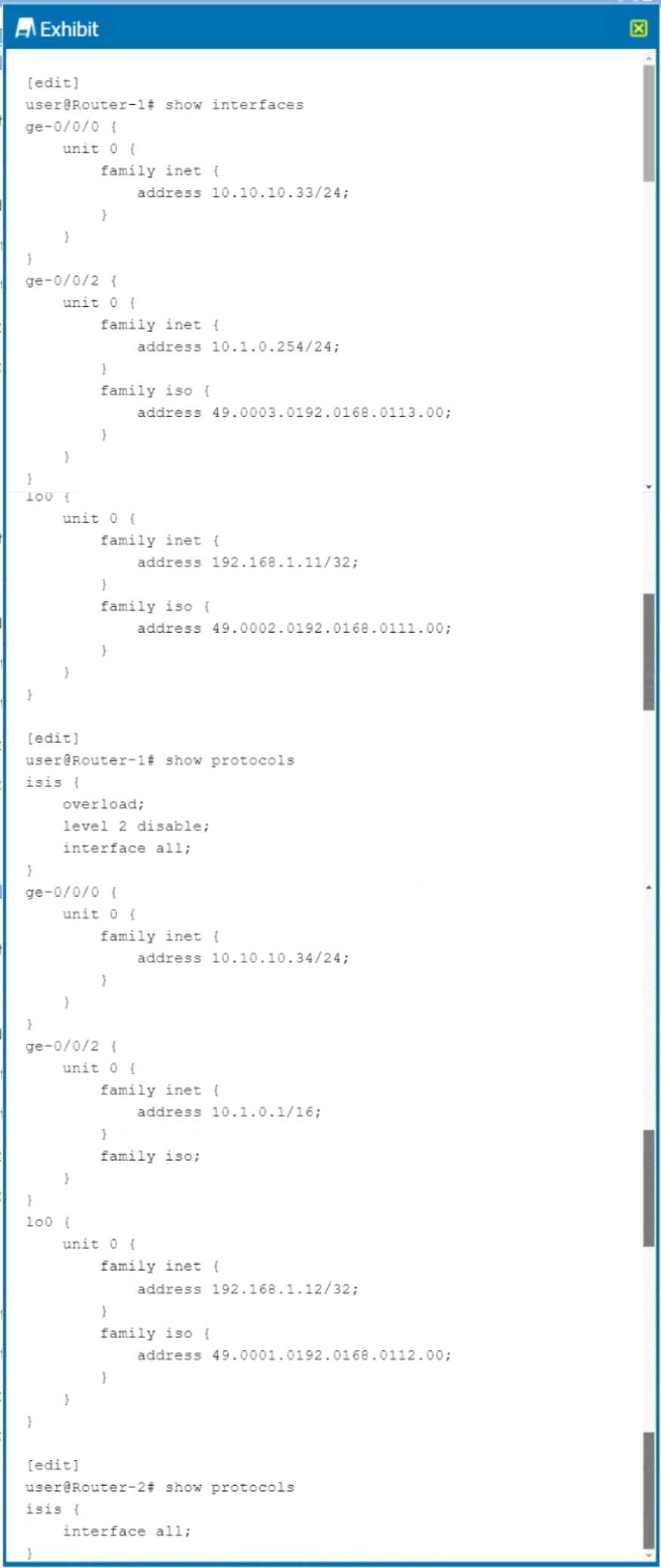Juniper jn0-349 practice test
Enterprise Routing and Switching, Specialist Exam
Question 1
What are three types of port designation specific to Private VLANs? (Choose three.)
- A. Promiscuous ports
- B. Transparent ports
- C. PVLAN trunk ports
- D. Designated ports
- E. Isolated ports
Answer:
A,C,E
Question 2
What types of authentication are supported in Junos for OSPF?
- A. Simple password
- B. MD5 checksum
- C. Hitless key chain of MD5 keys/checksums
- D. All of the above
Answer:
D
Question 3
You were provided a network diagram that told you to number your network from the
191.255.0.0/16 space. OSPF is enabled and adjacencies are up, but no routers are learning any
routes. What can explain this?
- A. The default OSPF export policies advertise nothing, so you need to apply export policy
- B. The default OSPF import policy rejects all OSPF routes, so you need to apply import policy
- C. You need to modify the martian table with a 191.255.0.0/16 accept statement
- D. You need to enable OSPF on the lo0 interface to provide a route to the RID of each router in the network
Answer:
C
Question 4
What BGP attribute is mostly likely to influence a remote AS that you do not peer with?
- A. This is not possible given the local scope of BGP
- B. AS path
- C. MED
- D. Local preference
Answer:
B
Question 5
What kind of filter would be written to protect control traffic destined for the switch?
- A. A filter applied to the default VLAN
- B. A filter applied to the native VLAN
- C. A filter applied to the management interface
- D. A filter applied to the loopback interface
Answer:
D
Question 6
You are a service provider and have multiple customers in a building.
You are installing a new switch that can host all of your customers. However, you would like to ensure
that one customer cannot see or broadcast to another customer.
You would also like to have them use a common gateway IP address from the building. What should
be used to provide this access?
- A. VLAN
- B. private VLAN
- C. filter-based VLAN
- D. Layer 2 tunneling
Answer:
B
Question 7
Which mechanism is used to share routes between routing tables?
- A. RIB groups
- B. routing instances
- C. forwarding instances
- D. filter-based forwarding
Answer:
A
Question 8
When electing a DIS in an IS-IS network, what is used to break a priority tie?
- A. highest router ID
- B. highest MAC address
- C. lowest MAC address
- D. lowest router ID
Answer:
B
Explanation:
https://www.juniper.net/documentation/en_US/junos/topics/concept/routing-protocol-is-is-security-designated-router-understanding.html
Question 9
Exhibit.
You are attempting to set up VRRP with R1 and R2 being participating members. You want R1 to be
the master router and R2 to be the backup router with the virtual router they create being at address
172.25.100.1. The virtual router is not pinging from either User A or User B.
Referring to the exhibit, what must be done to correct the problem?
- A. The VRRP group value on R1 and R2 must match.
- B. A VRRP authentication type value is needed on R1 and R2.
- C. A VRRP policy is needed on R1 and R2.
- D. The VRRP priority value on R1 and R2 must match
Answer:
A
Explanation:
https://www.juniper.net/documentation/en_US/junos/topics/reference/configuration-statement/priority-edit-interfaces-vrrp.html
Question 10
An EBGP session sources its TCP connection from which IP address?
- A. The IP address of the primary address assigned to the loopback interface.
- B. The IP address of the preferred address assigned to the loopback interface.
- C. The IP address of the interface that connects the two BGP speakers.
- D. The IP address assigned as the router ID.
Answer:
C
Question 11
Which statement is true about IP-IP tunnels?
- A. The time-to-live value of the original packet Is decremented.
- B. IP-IP tunnels are protocol agnostic.
- C. The packet is encapsulated unchanged before entering the tunnel
- D. The packet header is replaced before entering the tunnel
Answer:
C
Question 12
Which two statements are true about high availability on Junos devices? (Choose two.)
- A. BFD is faster at detecting failures than default GRE or OSPF timers.
- B. NSR is independent of helper routers to assist the routing platform in restoring routing protocol information.
- C. NSR is dependent on helper routers to assist the routing platform in restoring routing protocol information.
- D. BFD is slower at detecting failures than default GRE or OSPF timers.
Answer:
AB
Explanation:
https://www.juniper.net/documentation/en_US/junos/topics/concept/nsr-overview.html
Question 13
What are two interarea OSPF LSA types? (Choose two.)
- A. Type 1 router LSAs
- B. Type 2 network LSAs
- C. Type 3 summary LSAs
- D. Type 4 ASBR summary LSAs
Answer:
CD
Question 14
Exhibit.
Referring to the exhibit, why is the route for 10.5.5.5 hidden?
- A. It is an L3VPN route.
- B. The next hop cannot be resolved.
- C. It has an invalid community.
- D. It is a Martian route.
Answer:
B
Question 15
Exhibit.
Referring to the exhibit, Router-1 and Router-2 are failing to form an IS-IS adjacency.
What should you do to solve the problem?
A.
Remove the overloaded statement from Router-1.
B.
Change the IP subnet masks to match on the ge-0/0/2 interfaces of both routers.
C.
Remove the ISO address from ge-0/0/2 on Router-1.
D.
Change the ISO areas on the Io0 interfaces to match on both routers.
Answer:
B